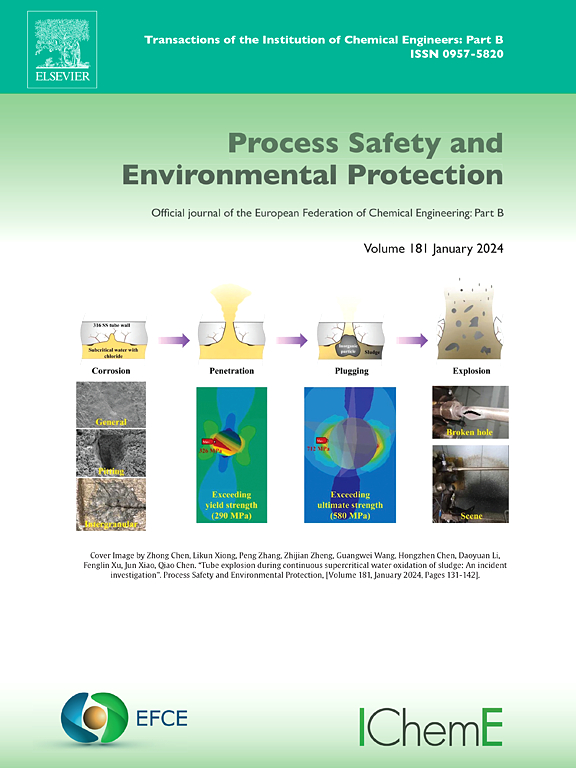碱焙烧浸出条件对富铁尾矿中稀土元素回收的影响——深共晶溶剂研究
IF 6.9
2区 环境科学与生态学
Q1 ENGINEERING, CHEMICAL
引用次数: 0
摘要
尾矿的后处理作为一种回收包括稀土元素在内的关键矿物的可持续方法已引起人们的广泛关注。虽然使用矿物酸的湿法冶金方法被广泛研究并被认为是有效的,但其对环境的影响仍然是一个主要问题。本研究探索了深共晶溶剂(DESs)作为从澳大利亚富铁尾矿中回收稀土的环保替代品。考察了6种不同DES配方的浸出效率,并考察了碱焙烧对回收率的影响。此外,我们还将最有效的DES与常用的矿物酸——h₂SO₄、HCl和HNO₃进行了比较。研究结果表明,在250°C下,KOH碱焙烧30 分钟,然后用氯化胆碱(ChCl)和对甲苯磺酸(PTSA)组成的DES以2:1的摩尔比浸出是最有效的方法。该方法对总稀土元素(TREEs)和铁的浸出效率高达95% %,物质溶出率为94% %,显著优于其他DES配方和三种矿物酸。ChCl:PTSA的优异性能归因于KOH焙烧,通过将复杂的矿物基质分解成更简单的氧化物,促进了稀土的释放。此外,由于KOH焙烧的温度更低,持续时间更短,因此比传统焙烧所需的能量更少。基于des的ChCl:PTSA浸出工艺为从富铁尾矿中回收稀土提供了一种有前景的绿色替代方案,在温和的操作条件下具有较高的效率,同时减少了对环境的影响。本文章由计算机程序翻译,如有差异,请以英文原文为准。
Impact of alkali roasting and leaching conditions on the recovery of rare earth elements from iron-rich mine tailings: A study using deep eutectic solvents
Reprocessing of mine tailings has gained significant attention as a sustainable approach for recovering critical minerals, including rare earth elements (REEs). While hydrometallurgical methods using mineral acids are widely studied and recognized as effective, their environmental impact remains a major concern. This study explores deep eutectic solvents (DESs) as eco-friendly alternatives for recovering REEs from Fe-rich Australian tailings. Six different DES formulations were evaluated for their leaching efficiency, and the impact of alkali roasting on recovery efficiency was assessed. Additionally, the performance of the most effective DES was compared against the commonly used mineral acids—H₂SO₄, HCl, and HNO₃. The findings identified alkali roasting with KOH at 250 °C for 30 minutes, followed by leaching with a DES composed of choline chloride (ChCl) and p-toluenesulfonic acid (PTSA) in a 2:1 molar ratio, as the most efficient approach. This method achieved up to 95 % leaching efficiency for total rare earth elements (TREEs) and Fe, along with 94 % material dissolution—significantly outperforming other DES formulations and the three mineral acids. The superior performance of the ChCl:PTSA was attributed to KOH roasting, which enhanced REEs liberation by breaking down complex mineral matrices into simpler oxides. Furthermore, KOH roasting required less energy than conventional roasting due to its lower temperature and shorter duration. The DES-based leaching process using ChCl:PTSA offered a promising green alternative for REEs recovery from Fe-rich tailings, providing high efficiency under mild operating conditions while reducing environmental impact.
求助全文
通过发布文献求助,成功后即可免费获取论文全文。
去求助
来源期刊

Process Safety and Environmental Protection
环境科学-工程:化工
CiteScore
11.40
自引率
15.40%
发文量
929
审稿时长
8.0 months
期刊介绍:
The Process Safety and Environmental Protection (PSEP) journal is a leading international publication that focuses on the publication of high-quality, original research papers in the field of engineering, specifically those related to the safety of industrial processes and environmental protection. The journal encourages submissions that present new developments in safety and environmental aspects, particularly those that show how research findings can be applied in process engineering design and practice.
PSEP is particularly interested in research that brings fresh perspectives to established engineering principles, identifies unsolved problems, or suggests directions for future research. The journal also values contributions that push the boundaries of traditional engineering and welcomes multidisciplinary papers.
PSEP's articles are abstracted and indexed by a range of databases and services, which helps to ensure that the journal's research is accessible and recognized in the academic and professional communities. These databases include ANTE, Chemical Abstracts, Chemical Hazards in Industry, Current Contents, Elsevier Engineering Information database, Pascal Francis, Web of Science, Scopus, Engineering Information Database EnCompass LIT (Elsevier), and INSPEC. This wide coverage facilitates the dissemination of the journal's content to a global audience interested in process safety and environmental engineering.
 求助内容:
求助内容: 应助结果提醒方式:
应助结果提醒方式:


